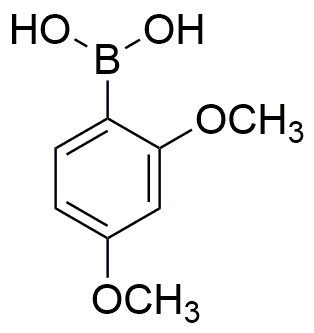2,4-Dimethoxyphenylboronic acid is widely utilized in research focused on:
- Organic Synthesis: This compound serves as a versatile building block in the synthesis of various organic molecules, particularly in the development of pharmaceuticals and agrochemicals.
- Cross-Coupling Reactions: It is commonly used in Suzuki-Miyaura coupling reactions, which are essential for forming carbon-carbon bonds, making it valuable in the production of complex organic compounds.
- Bioconjugation: The boronic acid functionality enables selective binding to diols, facilitating the development of bioconjugates for drug delivery systems and diagnostic applications.
- Material Science: This compound is applied in the creation of advanced materials, such as polymers and nanocomposites, enhancing their properties through boron chemistry.
- Sensor Development: Its ability to interact with sugars and other biomolecules makes it useful in designing sensors for glucose monitoring and other biochemical applications.
General Information
Properties
Safety and Regulations
Applications
2,4-Dimethoxyphenylboronic acid is widely utilized in research focused on:
- Organic Synthesis: This compound serves as a versatile building block in the synthesis of various organic molecules, particularly in the development of pharmaceuticals and agrochemicals.
- Cross-Coupling Reactions: It is commonly used in Suzuki-Miyaura coupling reactions, which are essential for forming carbon-carbon bonds, making it valuable in the production of complex organic compounds.
- Bioconjugation: The boronic acid functionality enables selective binding to diols, facilitating the development of bioconjugates for drug delivery systems and diagnostic applications.
- Material Science: This compound is applied in the creation of advanced materials, such as polymers and nanocomposites, enhancing their properties through boron chemistry.
- Sensor Development: Its ability to interact with sugars and other biomolecules makes it useful in designing sensors for glucose monitoring and other biochemical applications.
Documents
Safety Data Sheets (SDS)
The SDS provides comprehensive safety information on handling, storage, and disposal of the product.
Product Specification (PS)
The PS provides a comprehensive breakdown of the product’s properties, including chemical composition, physical state, purity, and storage requirements. It also details acceptable quality ranges and the product's intended applications.
Certificates of Analysis (COA)
Search for Certificates of Analysis (COA) by entering the products Lot Number. Lot and Batch Numbers can be found on a product’s label following the words ‘Lot’ or ‘Batch’.
*Catalog Number
*Lot Number
Certificates Of Origin (COO)
This COO confirms the country where the product was manufactured, and also details the materials and components used in it and whether it is derived from natural, synthetic, or other specific sources. This certificate may be required for customs, trade, and regulatory compliance.
*Catalog Number
*Lot Number
Safety Data Sheets (SDS)
The SDS provides comprehensive safety information on handling, storage, and disposal of the product.
DownloadProduct Specification (PS)
The PS provides a comprehensive breakdown of the product’s properties, including chemical composition, physical state, purity, and storage requirements. It also details acceptable quality ranges and the product's intended applications.
DownloadCertificates of Analysis (COA)
Search for Certificates of Analysis (COA) by entering the products Lot Number. Lot and Batch Numbers can be found on a product’s label following the words ‘Lot’ or ‘Batch’.
*Catalog Number
*Lot Number
Certificates Of Origin (COO)
This COO confirms the country where the product was manufactured, and also details the materials and components used in it and whether it is derived from natural, synthetic, or other specific sources. This certificate may be required for customs, trade, and regulatory compliance.


